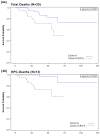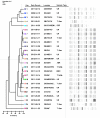Clinical Usefulness of Klebsiella Pneumoniae Carbapenemase-Producing K. Pneumoniae Genotyping: The Experience of a Single-Center Epidemic
- PMID: 30993245
- PMCID: PMC6457170
- DOI: 10.20411/pai.v1i2.109
Clinical Usefulness of Klebsiella Pneumoniae Carbapenemase-Producing K. Pneumoniae Genotyping: The Experience of a Single-Center Epidemic
Abstract
Background: During the last decade, the spread of Klebsiella pneumoniae-carbapenemase-producing Klebsiella pneumoniae (KPC-Kp) has increased dramatically worldwide. In this scenario, growing interest has been addressed to genotyping of KPC-Kp strains, which emerged as an important tool for a better understanding of the epidemiological and clinical characteristics of the outbreaks.
Methods: We performed a retrospective cohort study on patients infected with KPC-Kp during a 28-month outbreak period (January 2010-April 2012) at San Gerardo Hospital (Monza, Italy), investigating KPC-Kp genotypes by means of repetitive element sequence-based polymerase chain reaction (Rep-PCR).
Results: We enrolled 97 patients infected with KPC-Kp. Rep-PCR analysis identified 5 distinct clone types, with different distribution over time. During the first 12 months of the outbreak period, only 1 clone was detected (clone A, in 47 patients), while the 4 other clones were identified over the remaining 16 months (clones C, E, and F/L in 23, 24, and 3 patients respectively). Mechanical ventilation was less frequent in patients infected with clones C/E/F/L (OR = 0.14; 95% CI: 0.05-0.37) compared to clone A, and the Charlson comorbidity index (CI) was more likely to have a score >5 in patients infected with clones C/E/F/L (OR = 7.21; 95% CI: 2.24-23.14) compared to clone A.Overall mortality was higher in patients infected with clones C/E/F/L (13/20 patients, 65%) compared to those infected with clone A (7/20, 35%). Mortality in patients infected with clones C/E/F/L remained significantly higher even after adjusting for the potential confounding effect of comorbidities (ie, CI), with a hazard ratio (HR) of 4.65 (95% CI: 1.83-11.89).
Conclusions: Our results suggested a close relationship between strain genotype and clinical outcome.
Keywords: Enterobacteriaceae; KPC-Kp; carbapenemases; drug-resistant; genotyping profiles.
Conflict of interest statement
All authors: No reported conflicts. Conflicts that the editors consider relevant to the content of the manuscript have been disclosed.
Figures





References
-
- Munoz-Price LS, Poirel L, Bonomo RA, Schwaber MJ, Daikos GL, Cormican M, Cornaglia G, Garau J, Gniadkowski M, Hayden MK, Kumarasamy K, Livermore DM, Maya JJ, Nordmann P, Patel JB, Paterson DL, Pitout J, Villegas MV, Wang H, Woodford N, Quinn JP. Clinical epidemiology of the global expansion of Klebsiella pneumoniae carbapenemases. Lancet Infect Dis. 2013;13(9):785–96. PubMed PMID: 23969216. Pubmed Central PMCID: 4673667. doi: 10.1016/S1473-3099(13)70190-7 - DOI - PMC - PubMed
-
- Yigit H, Queenan AM, Anderson GJ, Domenech-Sanchez A, Biddle JW, Steward CD, Alberti S, Bush K, Tenover FC. Novel carbapenem-hydrolyzing beta-lactamase, KPC-1, from a carbapenem-resistant strain of Klebsiella pneumoniae. Antimicrob Agents Chemother. 2001;45(4):1151–61. PubMed PMID: 11257029. Pubmed Central PMCID: 90438. doi: 10.1128/AAC.45.4.1151-1161.2001 - DOI - PMC - PubMed
LinkOut - more resources
Full Text Sources
Miscellaneous
